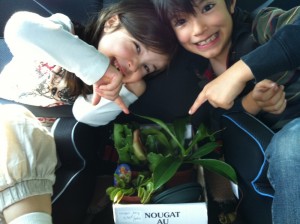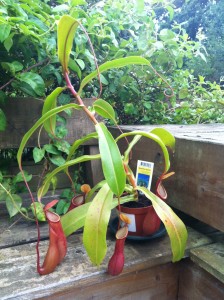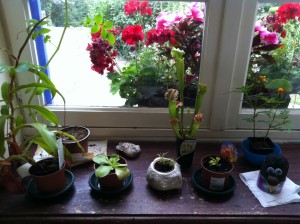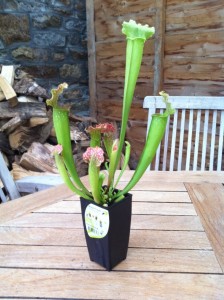Most kids I’ve met love carnivorous plants! My own children are fascinated by them; we’ve assembled a small collection of different species of carnivorous plant along our kitchen windowsill at home. My son can watch them for ages, watering them, pruning them, and hoping that he’ll be around when a fat, juicy bug buzzing around nearby unwittingly becomes one of their next meals.
Carnivorous plants can have the same effect in an elementary school classroom, teaching children about science in a hands-on and engaging manner. Here are my five reasons why you might want to stock a few of these interesting and unique plants in your own classroom.
1. Kids are fascinated by carnivorous plants
There’s something about carnivorous plants that most kids – and perhaps most adults as well – find intriguing. Carnivorous plants obtain most of the nutrients they need for survival by trapping and consuming small animals such as insects. It’s mind-boggling that carnivorous plants evolved to the point where they could derive the nutrients they lacked from insects and other life forms that they managed to ensnare. And what’s more, several different species of carnivorous plant evolved to perform this activity in different ways, independent of one another. That’s amazing!
2. Caring for living things teaches children responsibility
Taking care of living things, carnivorous plants or otherwise, teaches children responsibility. As part of your students’ daily tasks you can set a task for caring for the carnivorous plants that you have lined up along your classroom windowsill. Tasks that students must accomplish include:
- Watering the plants – carnivorous plants tend to originate in marshy environments, and enjoy a lot of water
- Pruning the plants – plants appreciate a good pruning; removing dead leaves can help a plant to thrive
- Removing dead insects – perhaps not the most fun of jobs, but if you remove a fly carcass from the leaf of a Venus Flytrap, the plant can re-use that trap for its next meal
- Caring for and respecting the plants – if you’re going to keep living things in your classroom, you need to teach your children to care for – and about – them. The traps of a Venus Flytrap, for example, are quite fragile and can only be used five or six times each. Most children will want to set off the traps of a Venus Flytrap using a pencil or a toothpick, but it’s much better for the plant if you don’t!
3. While tending their carnivorous plants, students are learning about science
One of the best ways to learn is to learn without knowing you’re learning! Venus Flytraps and other carnivorous plants are evolutionary marvels, and by studying these plants we can learn a wealth of interesting things about:
- Biology, botany, and chemistry
- Adaptation, evolution, and ecosystems
- Life, death, survival, and the circle of life.
Plants in general offer students a great number of important scientific topics that can be studied – how plants create food using the process of photosynthesis, for example, or the way the water cycle works in the Earth’s atmosphere. Learning from diagrams or reading short texts works well, but to have a small indoor garden of living plants can take your teaching of these topics to the next level. As kids learn to care about the things they are growing, they will also want to know more about the science behind the life forms they are caring for, and to associate that scientific knowledge with something fun and interesting.
4. Plants can brighten up a classroom
If you’re going to teach your students about science, you may as well do it in a way that also brightens up your classroom! Plants are colorful and interesting to look at, and having plants in a workplace or classroom can help to alleviate stress and put people at ease. Adding a few plants to your classroom can give it extra character and class.
The best place to keep your carnivorous plants is a low windowsill, ledge or shelf right beside a window that lets in plenty of natural sunlight. Carnivorous plants tend to like plenty of light. Make sure that your plants are in a location where your students can get close to them to investigate them, to see if they’ve caught any lunch for today, and to make sure that their soil is continually moist and never dry to the touch.
5. Carnivorous plants are amazing
I’ve mentioned that kids are fascinated by carnivorous plants, and for good reason. Carnivorous plants are amazing! Think about all that they have been able to accomplish:
- Carnivorous plants are, for the most part, an ancient species; pitcher plants, for example, originated in prehistoric times
- Carnivorous plants have adapted to find a way to get nutrients from animals when they were unable to get nutrients from the soil where they grew – mostly in acidic bogs or on rocky outcroppings
- There are several different species of carnivorous plant, many evolving independently from the others to trap small animals in different manners: the Venus Flytrap captures insects in its traps, the pitcher plant catches ants and other insects in its slick-walled funnels, while the sundew ensnares insects by using a sticky glue
- Some carnivorous plants (such as the larger pitcher plants found in Borneo, in southeast Asia) can trap larger animals such as frogs, birds, or mice. How amazing is that?
And to top it all off…
If you’ve got carnivorous plants on your windowsill, maybe they’ll help to control the population of pesky insects in your classroom. And that can only be a good thing… unless, of course, you happen to be studying a unit on bugs!








I am teaching science to third graders this year and I think they would love to take care of a carnivorous plant. I am going to search around to see if I can find out. I can’t wait! Thanks for the great idea!
Jana
Thinking Out Loud
Thanks for the comment Jana – I’m really glad that I may have helped to inspire you!
We visited a local garden store in our nearby town, and they had a small section filled with carnivorous plants. They had Venus Flytraps, sundews, butterworts, and two types of pitcher plant. They weren’t very expensive either – maybe five euros per plant, which isn’t too bad for a species that isn’t native to the region. Our kids were ecstatic! The first picture in the blog post above is of the kids in the back seat of the car on the way home from the garden store with their “haul” – they were very excited about their find.